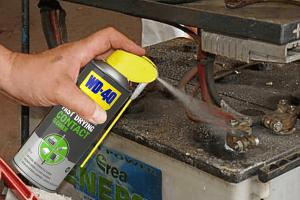Ultimate Guide on Cleaning Battery Corrosion and Build-Up: Step-by-Step Solutions

-
Quick Links:
- Introduction
- What is Battery Corrosion?
- Why Do Batteries Corrode?
- Signs of Battery Corrosion
- Tools and Materials Needed
- Step-by-Step Guide to Cleaning Battery Corrosion
- Preventing Battery Corrosion
- Case Studies
- Expert Insights
- FAQs
Introduction
Batteries are essential components in many of our daily devices, from remote controls to power tools. However, over time, they can develop corrosion that not only affects their performance but can also pose safety risks. In this comprehensive guide, we will explore the ins and outs of battery corrosion, how to clean it effectively, and preventative measures to keep your batteries in prime condition.
What is Battery Corrosion?
Battery corrosion typically refers to the buildup of white, ashy substance that forms on the terminals of batteries. This corrosion is primarily caused by a chemical reaction between the battery's acid and the metal terminals, leading to the formation of various compounds, primarily lead sulfate and zinc oxide.
Why Do Batteries Corrode?
Corrosion can occur for several reasons, including:
- Leakage: Most commonly, battery leakage occurs due to overcharging or aging batteries, causing the acid inside to escape.
- Humidity: High moisture levels can accelerate corrosion.
- Temperature Fluctuations: Extreme temperature changes can lead to condensation, further contributing to corrosion.
- Poor Maintenance: Neglecting regular checks on batteries can lead to buildup over time.
Signs of Battery Corrosion
Identifying early signs of battery corrosion can save your devices from performance issues:
- White, ashy substance around battery terminals
- Difficulty in connecting or disconnecting batteries
- Device malfunction or failure to start
- Swelling or bulging of battery casing
Tools and Materials Needed
Before you begin cleaning, ensure you have the following tools and materials on hand:
- Baking soda
- Water
- Toothbrush or small brush
- Safety goggles
- Gloves
- Vinegar or lemon juice (optional)
- Paper towels or rags
Step-by-Step Guide to Cleaning Battery Corrosion
Follow these steps carefully to clean battery corrosion safely:
Step 1: Safety First
Before starting, ensure you are wearing safety goggles and gloves. This will protect you from any acid that may be present.
Step 2: Remove the Battery
Carefully remove the battery from the device. If it's stuck, do not force it; instead, check for any screws or fasteners that may be holding it in place.
Step 3: Prepare the Cleaning Solution
Mix a tablespoon of baking soda with a small amount of water to create a paste. Baking soda neutralizes the acid and helps to clean the corrosion.
Step 4: Apply the Cleaning Solution
Using the toothbrush or small brush, apply the baking soda paste to the corroded areas. Allow it to sit for about 10 minutes to break down the corrosion.
Step 5: Scrub the Corrosion
Gently scrub the terminals and the surrounding area with the brush. Be careful to avoid damaging the terminals themselves. You should see the corrosion coming off.
Step 6: Rinse and Dry
Once the corrosion is removed, rinse the area with water. Make sure to dry it thoroughly with a paper towel or rag.
Step 7: Reinstall the Battery
Once everything is dry, reinstall the battery into the device. Make sure it fits snugly and securely.
Preventing Battery Corrosion
To keep your batteries in excellent condition and prevent corrosion, consider these tips:
- Regularly check batteries for signs of wear or corrosion.
- Store batteries in a cool, dry place.
- Avoid mixing old and new batteries in devices.
- Remove batteries from devices that won't be used for an extended period.
Case Studies
Several studies have shown the impact of battery maintenance on device longevity. For instance, a research paper published by the U.S. Department of Energy highlights the correlation between regular battery maintenance and device performance.
Expert Insights
According to battery specialist Dr. Emily Nguyen, "Regular maintenance can extend the life of your batteries significantly. Simple cleaning can prevent minor issues from becoming major problems." Her insights emphasize the importance of proactive care in battery management.
FAQs
1. What causes battery corrosion?
Battery corrosion is primarily caused by leakage of battery acid, humidity, and temperature fluctuations.
2. How can I tell if my battery is corroded?
Look for a white, powdery substance on the terminals, difficulty in connecting/disconnecting, or device malfunction.
3. Is battery corrosion dangerous?
Yes, it can be harmful, as it may lead to acid burns or damage to devices if not handled properly.
4. Can I clean battery corrosion with vinegar?
Yes, vinegar can neutralize battery acid, but baking soda is often more effective for cleaning.
5. How often should I clean my batteries?
It's a good practice to clean batteries every few months or whenever you notice corrosion.
6. What should I do if my battery is leaking?
Wear gloves, remove the battery safely, and clean the area with baking soda paste. Dispose of the leaking battery properly.
7. Can I use water to clean battery terminals?
Yes, but make sure to dry the area thoroughly afterward to prevent further corrosion.
8. What type of batteries are most prone to corrosion?
Alkaline and lead-acid batteries are particularly susceptible to corrosion.
9. Can I prevent battery corrosion?
Yes, by regularly checking batteries, storing them properly, and removing them from unused devices.
10. Is it safe to use a corroded battery?
No, using corroded batteries can be dangerous and may damage your device further.
By following the steps outlined in this guide, you can effectively clean battery corrosion and ensure that your devices operate at their best. Remember, regular maintenance is key to prolonging the life of your batteries and devices!